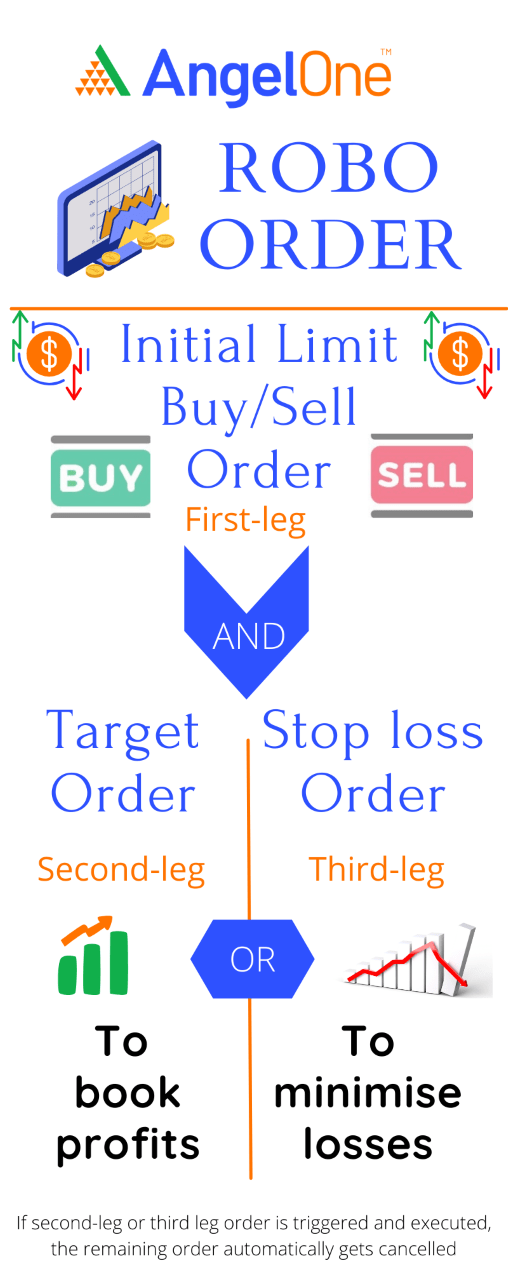Are you interested in intraday trading?
Do you find it difficult to make time for trading from your busy schedule?
Now, trade intraday at ease with our Robo Orders, and get back to your work on time.
What is a Robo Order?
A Robo order is a multi-leg order used in intraday trading that allows you to place two more orders along with your initial order. Among the other two orders, one of the orders is to set returns at the specified price and the other is to minimise losses at a trigger price.

Important features of Robo Order
- Robo order can only be placed in Intraday trading
- It is a 3-leg order that includes an initial Buy/Sell Limit Order followed by a Target order and a Stop loss order
- Saves your time as you need not keep a tab on market movements all time. Just place your orders and get back to your work.
- Effective in minimising losses with Trailing stop loss feature
How do Robo Orders work?
Robo order works as follows:
| Case 1: | Case2: |
| If the initial order is a Buy order, then both the Target and Stop-loss orders should be Sell orders. | If the initial order is a Sell order, then both the Target and Stop-loss orders should be Buy orders. |
For instance, if you are buying the shares of Company XYZ at ₹ 1000, and want to place a Robo order, let us assume you’ve placed,
Once the initial limit order is filled and any of the 2 following orders is triggered and executed, the remaining order will automatically get cancelled. In the above case,
|
For instance, if you are selling the shares of Company XYZ at ₹ 1000, and want to place a Robo order, let us assume you’ve placed,
Once the initial Limit order is filled and any of the 2 following orders is triggered and executed, the remaining order will automatically get cancelled. In the above case,
|
| Note: If your first-leg order is executed and neither the second-leg nor the third-leg order gets executed your position will get auto-squared off at 3:10 pm. | |
Trailing Stop loss in Robo Orders
The Robo Order comes with a unique feature of trailing stop loss, where you can trail your losses to minimise the losses and generate the possible returns out of every trade by setting a LTP Jump Price.
Case 1:For example, if you are buying a scrip ‘X’ at a limit price of ₹ 100 with a Stop loss Sell order placed at ₹ 90 and target price at ₹ 110, and if you have set a LTP jump price of ₹ 2, then for every ₹ 2 rise in Last Traded Price (LTP), Stop loss Sell order trigger price will jump by ₹ 2.
- In the above case, if LTP becomes ₹ 102, the trigger price for Stop loss sell order will jump to ₹ 92 and so on.
- However, the stop loss remains unchanged if the LTP goes down in this case. The Stop loss trigger price remains at ₹ 90 if the LTP falls below ₹ 100.
Case 2:For example, if you are selling a scrip ‘X’ at a limit price of ₹ 100 with Stop loss Buy order placed at ₹ 105 and target price at ₹ 90, and if you have set a LTP jump price of ₹ 2, then for every ₹ 2 fall in LTP, stop loss Buy order trigger price will fall by ₹ 2.
- In the above case, if LTP becomes ₹ 98, the trigger price for Stop loss Buy order will fall to ₹ 103 and so on.
- However, the stop loss remains unchanged if the price goes up in this case. The Stop loss trigger price remains at ₹ 105 if the LTP rises above ₹ 100.
Robo orders give you all the convenience you are looking for in Intraday trading. Now that you know how to place Robo orders, relax and enjoy your Intraday trading journey. Happy trading!!

